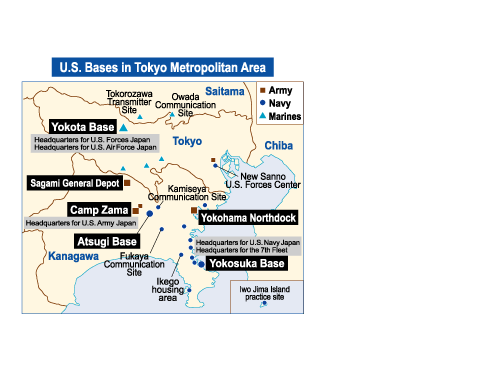
Cluster of U.S. bases in Metropolitan Tokyo
 Extraordinary for a capital city, Tokyo and its metropolitan areas have a number of U.S. military bases. The September 14 issue of Akahata explained how extraordinary the situation is in this part of Japan.
Extraordinary for a capital city, Tokyo and its metropolitan areas have a number of U.S. military bases. The September 14 issue of Akahata explained how extraordinary the situation is in this part of Japan.The Tokyo area with its overcrowded population has an extraordinarily concentrated presence of U.S. military bases; Yokosuka, the only homeport for the U.S. aircraft carrier other than those in the U.S. mainland, and two major air bases at Yokota (air force) and Atsugi (navy) exist.
These facts clearly indicate that Japan is "virtually a dependent country, with an important part of its land, military matters, and other affairs of state being controlled by U.S. imperialism." This is what the Japanese Communist Party in its draft revision to the JCP Program points out.
Unthinkable in Europe
The headquarters of the U.S. Forces in Japan and the U.S. Air Force in Japan are located at the U.S. Yokota Air Base in the outskirts of Tokyo, with an airlift wing functioning as a hub of the Pacific linking the U.S. mainland with Asia.
About a half million people living near the Yokota Air Base are exposed day and night to sonic booms from U.S. aircraft .
Only one homeport outside of the U.S. for aircraft carriers
Kanagawa Prefecture hosts 16 U.S. military bases, second only to Okinawa.
The U.S. Yokosuka Naval Base, a stronghold of the U.S. Seventh Fleet operating from the Western Pacific to Africa's East coast, has been used as the homeport of the U.S. aircraft carrier Kitty Hawk, the only homeport outside of the United States for U.S. aircraft carriers.
Also, one carrier-aircraft unit is deployed at the U.S. Atsugi Naval Air Station located in an area near Yamato and two other cities, the only deployment of this kind in the world.
The Kitty Hawk will reportedly retire before 2008 and will be replaced by a nuclear-powered carrier.
In March 1953, before the first Japan-U.S. Security Treaty came into effect, the Japanese and U.S. governments agreed that the U.S. ground and air forces in Japan would be deployed outside of urban areas and that the U.S. naval force would be concentrated in the minimum number of Japanese ports.
However, the U.S. has betrayed this agreement as it has increased its presence in Japan's urban areas in order to cover the whole of Asia and the Middle East with their reinforced military facilities.
The Pentagon's Quadrennial Report (2001 QDR) states that U.S. bases in Europe and Northeast Asia are assigned to play a new role as a hub in contingencies in regions outside of Asia or Europe.
Under this plan, a berth at the Yokosuka base is being extended and Army landing ships are being deployed to Yokohama Port's North Dock.
Sonic booms affect 1.5 million people
The U.S. Atsugi base is responsible for about 30,000 flights a year. U.S. aircraft fly over the densely populated area with a population of about one and a half million. Daily flight trainings by carrier aircraft are causing noises over 90 WECPNL (the Weighted Equivalent Continuous Perceived Noise Level), the highest level of all airfields in Japan in 1999 and 2000, exceeding those even of Kadena in Okinawa and Yokota in Tokyo.
Last July, residents had to live under extraordinary noise with low-altitude flights by U.S. aircraft coming back from the Iraq War. Many calls of protest were made to local governments concerned.
Also, night landing practices (NLPs) were carried out last January in preparation for the Iraq war. About 300 thousand people live within the area designated by the Japanese government to pay part of the cost for soundproofing. Such NLP operations do not take place on the U.S. mainland.
Deploying new aircraft needs further assessment in U.S.
The state-of-the-art aircraft FA18E Super Hornet is going to be deployed at the Atsugi Base in place of F14s. FA18Es, with an engine power increase of 133 percent over FA18's, will cause extremely serious noise pollution in this area.
A similar reformation is scheduled for the F14 squadron at the Oceana Naval Base in Virginia, the U.S.A. with about 400,000 residents near the base, where the U.S. Navy carried out an environmental assessment and held public hearings fourteen times. It recently decided to divide and deploy the squadron at two bases, and construct a landing on/off field away from the Oceania base.
In contrast, the U.S. Forces in Japan have done no assessment and held no public hearings. Notices of an introduction of new types of aircraft and carrying out of exercises to the Japanese side have always been made on extremely short notice. No public hearings have been held at all.
Japan's government urging people to endure noise
The Japanese government is to blame for giving top priority to allow the U.S. Forces operation without restriction in Japan. Defense Agency chief Ishiba Shigeru stated that the more U.S. pilots' skills are upgraded through NLPs, the more Japan's war deterrence is increased (February 18, 2003, at the Lower House Budget Committee).
This is the type of attitude that the people living near the U.S. bases must endure because U.S. bases are supposedly functioning in the service of Japan's national interest. (end)